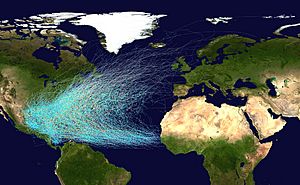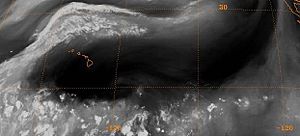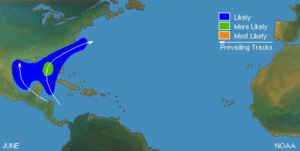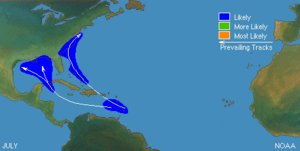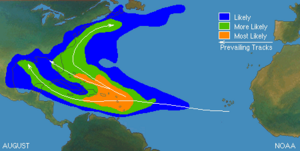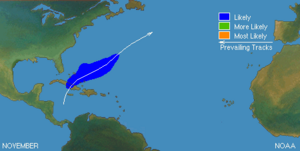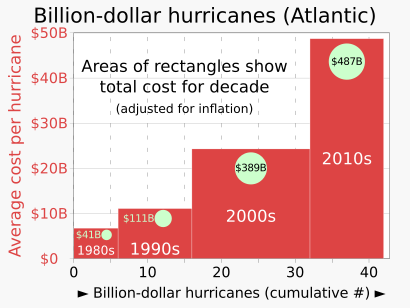Atlantic hurricane facts for kids
An Atlantic hurricane is a powerful type of storm called a tropical cyclone. These storms form in the Atlantic Ocean, mostly between June and November. You might hear these storms called "hurricanes," "typhoons," or "cyclones." They are all the same kind of weather event.
Hurricanes are huge spinning systems of clouds and thunderstorms. They start over warm ocean waters in tropical or subtropical areas. They have a closed low-level circulation, which means the air spins around a central point. Don't confuse them with tornadoes, which are much smaller and form over land.
The word "hurricane" is mainly used for storms in the North Atlantic, central North Pacific, and eastern North Pacific. In the Pacific Northwest, people usually say "typhoon." For storms in the South Pacific and Indian Ocean, the term "cyclone" is used.
Tropical cyclones are grouped by how strong they are. Some storms can cause a lot of damage, while others are much weaker. A "tropical storm" has winds of at least 39 miles per hour (63 km/h). A "hurricane" has winds stronger than 74 miles per hour (119 km/h).
Most North Atlantic tropical cyclones form between June 1 and November 30. The National Hurricane Center in the United States watches these storms. They issue reports and warnings to help people stay safe. This center is one of the main places in the world that tracks tropical cyclones.
Before the 1950s, storms were named in different ways. Then, they started giving them female names. Since 1953, storms have been named from a special list. If a hurricane causes a lot of damage or deaths, its name is removed from the list. This stops confusion if a similar storm happens later.
On average, about 14 named storms happen each year in the North Atlantic. About 7 of these become hurricanes, and 3 become major hurricanes. Major hurricanes are those that are Category 3 or stronger. The busiest time for hurricanes is usually around mid-September.
In March 2004, Catarina was the first hurricane-strength storm recorded in the South Atlantic Ocean. Since 2011, the Brazilian Navy has started naming tropical cyclones in the South Atlantic. They use the same strength scale as the North Atlantic.
Contents
How Hurricanes Move
Hurricanes are guided by the air currents around them. These currents are found throughout the troposphere. This is the layer of the atmosphere from the ground up to about 8 miles (13 km) high. Imagine a leaf floating in a stream or a brick moving through a river of air. This is how air currents affect a hurricane's path. Air flowing around high pressure systems and towards low-pressure areas guides where hurricanes go.
In tropical areas, storms and hurricanes usually move westward. They also tend to move slightly north. This is because they are influenced by the subtropical ridge. This is a high-pressure system that stretches from east to west across the subtropics. South of this ridge, winds usually blow from east to west.
If the subtropical ridge gets weaker, a tropical cyclone might turn north. Then it can curve back towards the northeast. This happens when it enters the main belt of westerly winds. North of the subtropical ridge, westerly winds are common. These winds usually move tropical cyclones that reach northern areas towards the east. These westerly winds also move other weather systems, like cold and warm fronts, from west to east.
Hurricane Strength
| Most intense Atlantic hurricanes | |||||
|---|---|---|---|---|---|
| Rank | Hurricane | Season | Pressure | ||
| hPa | inHg | ||||
| 1 | Wilma | 2005 | 882 | 26.05 | |
| 2 | Gilbert | 1988 | 888 | 26.23 | |
| 3 | "Labor Day" | 1935 | 892 | 26.34 | |
| 4 | Rita | 2005 | 895 | 26.43 | |
| 5 | Allen | 1980 | 899 | 26.55 | |
| 6 | Camille | 1969 | 900 | 26.58 | |
| 7 | Katrina | 2005 | 902 | 26.64 | |
| 8 | Mitch | 1998 | 905 | 26.73 | |
| Dean | 2007 | ||||
| 10 | Maria | 2017 | 908 | 26.81 | |
| Source: HURDAT | |||||
A tropical cyclone's strength is usually measured by its strongest winds or its lowest air pressure. The lower the air pressure in the center, the stronger the storm.
Hurricane Wilma in October 2005 became the strongest Atlantic hurricane ever recorded. Its central pressure dropped to 882 mbar. This made Wilma the strongest tropical cyclone in the world outside of the Pacific Ocean. Before Wilma, Hurricane Gilbert held the record for 17 years.
The 1935 Labor Day hurricane was the third strongest Atlantic hurricane. It had a pressure of 892 mbar. It was the strongest storm recorded before 1950. The pressure readings for Wilma and Gilbert were taken using special tools dropped into the storm. This means their pressures are the lowest ever measured over land.
Hurricane Rita is the fourth strongest Atlantic hurricane by pressure. It was one of three very dangerous storms from 2005 on this list, along with Wilma and Katrina. Rita had a pressure of 895 hPa. This makes it the strongest tropical cyclone ever recorded in the Gulf of Mexico.
Many of the strongest hurricanes become weaker before they hit land. However, some remain very powerful when they make landfall. The 1935 Labor Day hurricane hit land at its strongest point. This makes it the most intense Atlantic hurricane landfall ever. Hurricane Gilbert and Hurricane Camille also hit land with very low pressures.
Hurricane Season Patterns
| Total and Average Number of Tropical Storms by Month (1851–2017) |
|||
|---|---|---|---|
| Month | Total | Average per year | |
| January — April | 7 | <0.05 | |
| May | 22 | 0.1 | |
| June | 92 | 0.5 | |
| July | 120 | 0.7 | |
| August | 389 | 2.3 | |
| September | 584 | 3.5 | |
| October | 341 | 2.0 | |
| November | 91 | 0.5 | |
| December | 17 | 0.1 | |
| Source: NOAA FAQ | |||
Climatology helps us understand what a typical hurricane season is like. This information can be used to make forecasts. Most storms form from tropical waves in warm waters. These areas are usually several hundred miles north of the equator. The Coriolis force is usually too weak near the equator to start enough spinning for a storm.
Storms often form in the Gulf of Mexico, the Caribbean Sea, and the tropical Atlantic Ocean. They can also form as far east as the Cape Verde Islands. These are known as Cape Verde-type hurricanes. Storms can also get stronger over the Gulf Stream off the eastern United States coast. This happens where water temperatures are warmer than 26.5°C (79.7°F).
Sometimes, storms form further north and east. This can happen due to other weather events like cold fronts. These are called baroclinically induced tropical cyclones.
There's a strong link between Atlantic hurricane activity and El Niño or La Niña events in the Pacific Ocean. El Niño events increase wind shear over the Atlantic. This makes it harder for storms to form and reduces hurricane activity. La Niña, on the other hand, causes less wind shear. This leads to more hurricane activity.
Seasonal Changes
About 97 percent of tropical cyclones in the North Atlantic form between June 1 and November 30. These dates mark the official Atlantic hurricane season. The start date has stayed the same, but the end date has changed over time.
Sometimes, a tropical cyclone forms outside the official season. This happens every few years. As of September 2021, there have been 88 off-season tropical cyclones. The most recent was Tropical Storm Ana in May 2021.
The earliest tropical storm on record formed on January 3, 1938. The earliest Category 4 hurricane was Hurricane Dennis in 2005, which reached that strength on July 8. The earliest Category 5 hurricane was Emily in 2005. It reached its highest strength on July 17.
The official hurricane season ends on November 30. However, December has seen 14 tropical cyclones form. Tropical Storm Zeta in 2005 was the latest storm to become a tropical storm. It did so on December 30. Hurricane Alice in 1954 was the latest to become a hurricane. Zeta and Alice were the only two storms to exist in two different calendar years. No storms have reached Category 2 or higher in December.
June
June marks the start of hurricane season. This is when ocean temperatures begin to warm up. Not much activity usually happens in June. On average, only one tropical cyclone forms every two years. Storms usually form in the Gulf of Mexico or off the east coast of the United States.
Since 1851, 81 tropical storms and hurricanes have formed in June. Only three major hurricanes have formed in June since 1870. Hurricane Audrey in 1957 was one of them. It was stronger than any other June or July storm until Hurricanes Dennis and Emily in 2005.
July
July also has low tropical activity. Most hurricane seasons see one tropical cyclone form in July. The first tropical storm of the season usually forms by July 11. A second one often forms by August 8.
Storms usually form in the eastern Caribbean near the Lesser Antilles. They also form in the northern and eastern parts of the Gulf of Mexico. Other areas include the northern Bahamas and off the coast of The Carolinas and Virginia. Storms travel west through the Caribbean. Then they either move north and curve near the eastern U.S. coast or stay northwest and enter the Gulf of Mexico.
Since 1851, 105 tropical storms have formed in July. Ten of these reached major hurricane strength since 1870. Only Hurricane Emily in 2005 became a Category 5 hurricane. This makes it the earliest Category 5 hurricane on record.
August
Wind shear decreases from July to August. This causes tropical activity to increase. On average, 2.8 Atlantic tropical storms form each August. By August 30, there are usually four named tropical storms, including one hurricane. The first intense hurricane often develops by September 4.
September
September is the busiest month of the hurricane season. This is when wind shear is low and ocean temperatures are warmest. An average of three storms form each September. By September 24, the average season has seven named tropical storms, including four hurricanes. Also, two major hurricanes usually occur by September 28. Few tropical cyclones hit land at these strong intensities.
October
The good conditions for storms start to fade in October. The main reason is increasing wind shear. Ocean temperatures are also cooler than in September. In October, only 1.8 cyclones form on average. By October 21, the average season has nine named storms with five hurricanes. A third major hurricane occurs after September 28 in half of all Atlantic hurricane seasons. Storms tend to form more in the Caribbean and Gulf of Mexico during this month.
November
Wind shear from the westerlies increases in November. This generally stops cyclones from forming. On average, one tropical storm forms every other November. Major hurricanes are rare in November.
Some intense November hurricanes include the Cuba hurricane in 1932. This was the strongest November hurricane on record, reaching Category 5. Hurricane Lenny in 1999 was a late-developing Category 4 hurricane. Hurricane Kate in 1985 was the latest major hurricane until Hurricane Otto in 2016. Hurricane Paloma in 2008 was a Category 4 storm that hit Cuba. Hurricane Eta in 2020 became a Category 4 hurricane and hit Central America. In the same year, Hurricane Iota also became a Category 4 hurricane on November 16.
December to May
Even though the hurricane season is from June 1 to November 30, tropical cyclones have formed in every month of the year. Since 1870, there have been 32 off-season cyclones. Most of these (18) happened in May. Nine storms formed in December, two in April, and one each in January, February, and March.
High vertical wind shear and cool ocean temperatures usually prevent storms from forming during the off-season. Two December storms, Hurricane Alice (1954–55) and Tropical Storm Zeta (2005–06), lasted into the next year. Seven tropical or subtropical cyclones have formed in January. Two of these became Category 1 hurricanes: the first storm of 1938 and Hurricane Alex in 2016. No major hurricanes have occurred in the off-season.
Hurricane Records
Here are some records for Atlantic hurricanes:
- The year with the most tropical storms was 2020, with 30 storms.
- The year with the most hurricanes was 2005, with 15 hurricanes.
- The years 2005 and 2020 had the most major hurricanes (7 each).
- The least active season since 1946 was 1983, with only four tropical storms. The least active season overall was 1914, with just one storm.
- The strongest hurricane by lowest air pressure was Hurricane Wilma (2005), with 882 mbar.
- The largest hurricane (by how wide its strong winds stretched) was Hurricane Sandy (2012), with winds stretching 870 miles wide.
- The longest-lasting hurricane was the 1899 San Ciriaco hurricane, which lasted for over 27 days.
- Hurricane Ivan (2004) spawned the most tornadoes: 127.
- The strongest hurricane to hit land was the 1935 Labor Day hurricane (892 hPa).
- The deadliest hurricane was the Great Hurricane of 1780, which killed 22,000 people.
- The deadliest hurricane to hit the United States was the Galveston Hurricane in 1900, which may have killed up to 12,000 people.
- The most damaging hurricanes were Hurricane Katrina (2005) and Hurricane Harvey (2017). Both caused $125 billion in damages. When adjusted for inflation, Katrina is the costliest.
- The quickest-forming hurricane was Hurricane Humberto in 2007. It formed and got stronger very quickly before hitting Texas.
Hurricane Trends
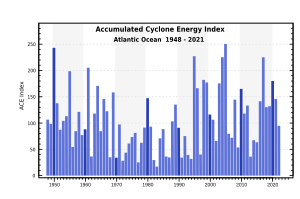
Past and Present Trends
Studies of past storms show that major hurricane activity along the Gulf of Mexico coast changes over hundreds or thousands of years. There were fewer major hurricanes from 3000–1400 BC and in the most recent thousand years. But between 1400 BC and 1000 AD, the Gulf coast was hit by hurricanes much more often.
This long-term change might be linked to shifts in the position of the Azores High. This is a large area of high pressure in the Atlantic. When the Azores High was in a more northeasterly spot, more hurricanes went towards the Atlantic coast. When it shifted southwest, more hurricanes went towards the Gulf coast.
Evidence also shows that the average location where hurricanes hit land has been moving northward. This shift has sped up recently. This is partly due to the Arctic Ocean warming up, especially from climate change caused by fossil fuels.
The number and strength of Atlantic hurricanes may also follow a 50–70 year cycle. This is called the Atlantic Multidecadal Oscillation. During some periods, there are more major hurricanes per year, and during others, there are fewer.
Climate Change and Hurricanes
Between 1979 and 2019, tropical cyclones became stronger. Globally, tropical cyclones are 8% more likely to reach major intensities (Category 3 to 5). This trend is especially strong in the North Atlantic. Here, the chance of cyclones reaching Category 3 or higher increased by 49% per decade. This matches what scientists expect from climate change.
While the number of storms in the Atlantic has increased since 1995, the total number of tropical cyclones worldwide has stayed about the same. However, it's hard for scientists to study long-term data in some parts of the world because there isn't enough reliable historical information.
Scientists have also noticed that the paths of the strongest tropical cyclones in the Atlantic are moving towards the poles. This means the storms are reaching their peak strength further north or south. Over the past 30 years, the peak intensity of these storms has shifted about 60 km (37 miles) per decade.
Hurricane Impact
Atlantic storms are causing more financial damage. Five of the ten most expensive storms in U.S. history have happened since 1990. This is largely because more people and buildings are located in coastal areas.
Some studies have looked at hurricane damage from 1900–2005 and adjusted it for inflation. They found that the total amount of damage hasn't necessarily increased. However, the 1970s and 1980s had less damage compared to other decades. The decade from 1996–2005 had the second most damage, only less than 1926–1935. The most damaging single storm was the 1926 Miami hurricane, which caused $157 billion in normalized damage.
In the past, some coastal areas had very few people. So, the worst parts of hurricanes hitting the coast might not have been fully recorded. Before planes and satellites, storms could go unnoticed. This happened unless a ship sailed through one, or it hit a populated area. Because of this, the official records before 1960 might not include all storms.
Few hurricane seasons were above normal from 1970 to 1994. But destructive hurricanes hit often from 1926 to 1960. In 1933, 21 Atlantic tropical storms formed. Only 2005 and 2020 had more storms (28 and 30, respectively). Few hurricanes occurred from the 1840s to 1860s. However, many hit in the early 1800s. Some experts believe these storms might have been as strong as Category 4.
See Also
- List of Atlantic hurricanes
- List of Category 5 Atlantic hurricanes
- List of costliest Atlantic hurricanes
- List of deadliest Atlantic hurricanes
- List of wettest tropical cyclones in the Atlantic Ocean
- List of Atlantic hurricane seasons
- List of off-season Atlantic hurricanes
- List of retired Atlantic hurricane names
- Tropical cyclone
- Tropical cyclone naming
- Tropical cyclone scales
- Tropical cyclone rainfall climatology
- Tropical cyclone warnings and watches
- Tropical cyclogenesis
- Climate change and tropical cyclones
Images for kids
-
Hurricane Katrina was the most expensive and one of the deadliest hurricanes in U.S. history.
-
Hurricane Harvey also caused historic and terrible flooding in Texas.


